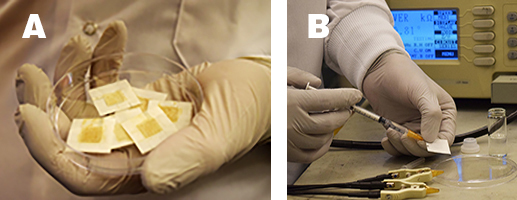Disposable yeast badges: A replacement for radiation dosimeters?
Research engineers from Purdue University in West Layfayette, IN, have developed a radiation sensing system using yeast fermentation to detect biological radiation damage. A disposable yeast badge may someday replace radiation dosimeters worn in radiology departments to monitor clinical staff exposure to radiation.
The experimental sensor is a wearable, disposable, film-type device fabricated on a paper substrate with yeast cells patterned between two electrodes. It is sensitive to radiation when dry and is read by activating it with water, according to co-author Babak Ziaie, PhD, professor of biomedical engineering at the Birck Nanotechnology Center of the School of Electrical and Computer Engineering.

(A) Disposable yeast badges developed by Purdue University researchers to measure radiation exposure. Courtesy Kayla Wiles, Purdue University. (B) Adding a drop of water to a badge activates yeast to show radiation exposure as read by an electronic device. Courtesy Kayla Wiles, Purdue University.
The authors explained that yeast (Saccharomyces cerevisiae) cells exposed to ionizing radiation and subsequently allowed to ferment a glucose solution, exhibit an electrical conductivity that is lower than that of nonexposed yeast. The electrical conductivity can be measured when the badge is hooked up to a readout system. Numbers from the readout system translate to rad units. The yeast badges have the ability to detect a radiation dose as low as 1 millirad, comparable to current commercial badges.
“We use the change in electrical properties of the yeast to tell us how much radiation damage it incurred,” said co-author Rahim Rahimi, PhD, a postdoctoral researcher in electrical and computer engineering said.
Purdue University has a patent pending for the technology via Purdue Research Foundation.
REFERENCE
- Yoon CK, Ochoa M, Kim A, et al. Yeast metabolic response as an indicator of radiation damage in biological tissue. Adv Biosyst. Published online August 8, 2018. doi.org/10.1002/adbi.201800126.